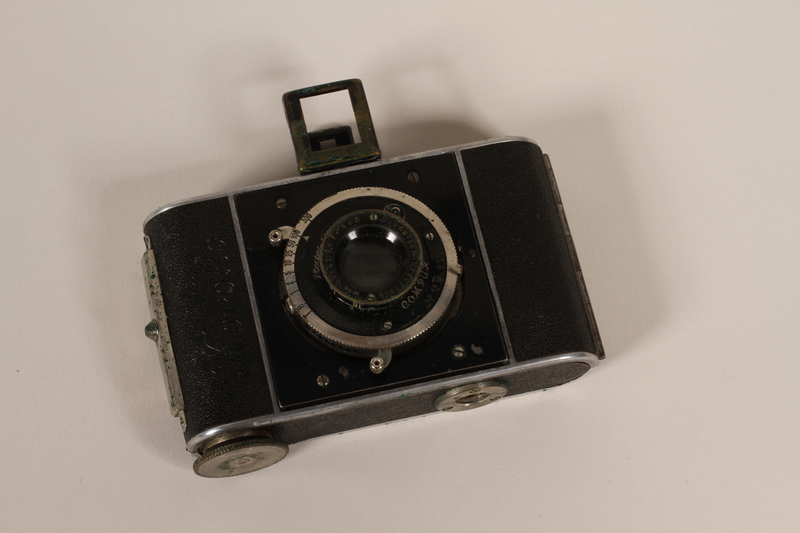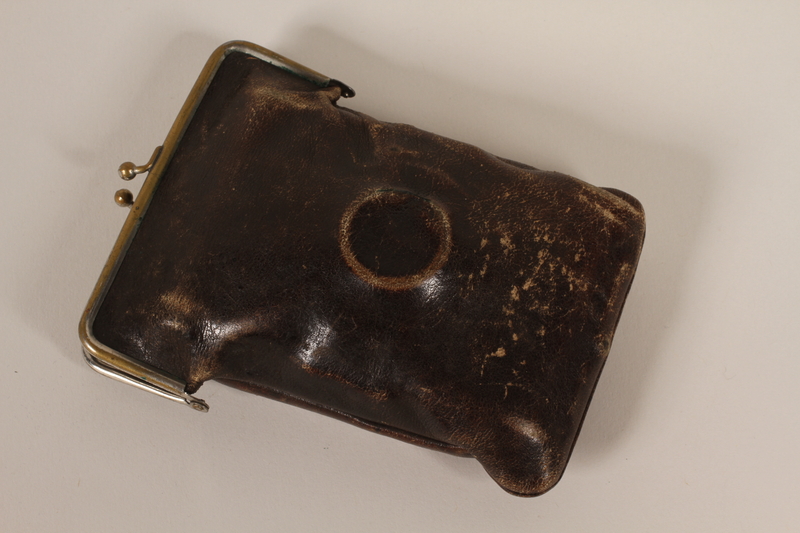Overview
- Brief Narrative
- Korelle 3X4 camera with a pouch for a case used by Venant Hanzelka while he, his wife Stepanka, and four year old daughter Hana lived in hiding from the Gestapo in German occupied Czechoslovakia from 1942-1945. Venant, Stepanka, and his brother, Alfons, joined an underground Czech resistance group after Germany forcibly annexed the Bohemia and Moravia provinces, which included Brno, where they lived, in March 1939. Alfons was arrested by the Gestapo and sent to Auschwitz concentration camp and killed in 1942. Stepanka and Hana went into hiding in an old mill in the forest near the town of Svojanov. Venant did not hide with them, but would occasionally come to meet them. During one of these meetings, Venant took a picture of Stepanka and Hana with his camera, which he kept with him throughout this time. The family remained in hiding until Germany surrendered on May 7, 1945. They returned to Brno, where Venant resumed his career.
- Date
-
use:
1942-1945
manufacture: after 1931
- Geography
-
use:
Svojanov (Pardubicky kraj, Czech Republic)
manufacture: Dresden (Germany)
- Credit Line
- United States Holocaust Memorial Museum Collection, Gift of Hana Strasen
- Markings
- front, left side, vertical text, pressed : Korelle
front, center, large metal ring, exterior, engraved : 2262693
front, center, large metal ring, top surface, engraved : T B 1 2 5 10 25 50 100 300
front, center, black inner ring, top surface, engraved, white paint : equilateral triangle / F. Deckel – München / COMPUR / 3.5 4.5 5.6 8 11 16 22 / maker’s mark F interlocked with a D
front, center, raised black lens ring, exterior, engraved, white paint : 1 1.2 1.5 2 3 6 OO
front, center, raised black lens ring, top surface, engraved : Radionar 1:3.5 F-5cm Schneider-Kreuznach - Contributor
-
Subject:
Venant Hanzelka
Manufacturer: Kochmann Fabrik
Subject: Hana Strasen
- Biography
-
Venant Hanzelka was born in 1906 in Frydek, Austria-Hungary (Fryldek-Milstek, Czech Republic). He had an older brother Alfons, born in 1896, also in Frydek. After the defeat of the Austro-Hungarian Empire in World War I (1914-1918), Bohemia, Moravia, and part of Silesia were unified into the nation of Czechoslovakia. Venant became an architect, settled in Brno, Czechoslovakia (Czech Republic), and married Stepanka. Alfons moved to Strelice, just outside of Brno, and worked for Czechoslovak State Railways as a chief clerk. Venant, Stepanka, and Alfons were active members in their local Sokols, gymnastic societies that promoted communal spirit, physical fitness, and nationalism on a local level. Alfons served as an officer in Sokol Strelice after its construction in 1932, and eventually became the county chief for Sokol Brno. Venant and Stepanka had their only child, Hana, on October 7, 1938, in Brno.
In September 1938, a conference was held in Munich where Great Britain, France and Italy agreed to Germany’s annexation of the Sudetenland region of Czechoslovakia in exchange for a promise of peace from Hitler. Czechoslovakia was not invited to the conference but was pressured to agree the plan. On March 15, 1939, Germany invaded and claimed the Bohemia and Moravia regions of Czechoslovakia, where Brno was located. Slovakia became independent and Hungary annexed the remaining Transcarpathian region. Czechoslovakia ceased to exist. Alfons, Venant, and Stepanka became active members of an underground group, Hal, opposed to the German occupiers. It was part of the democratic Defense of the Nation movement and was coordinated by the Czech Army. Alfons, because of his prominence as a Sokol official, was arrested on September 1, 1939, the same day Germany invaded Poland. He was held for several weeks in Spilberk Castle in Brno and then released. Venant continued to work as an architect and many of his designs were published in book form. In early 1940, the Defense of the Nation joined with several other democratic resistance groups. Until 1941, this new group, the Central Committee of the Home Resistance, received instructions from the Czech government-in-exile in London. On May 27, 1942, there was an assassination attempt on Reich Protector Reinhard Heydrich. He died of his injuries on June 4. The German reprisal was brutal, more than 3000 Czech citizens were arrested with over half killed, and the entire village of Lidice was decimated.
In 1942, Alfons was arrested by the Gestapo and imprisoned in Brno before being transported to Auschwitz concentration camp. His arrest caused Stepanka and Hana to go into hiding at an old mill in the woods near the town of Svojanov in the Pardubice region. Venant did not hide with them, but would meet them in the forest sometimes. Stepanka and Hana remained in hiding until Germany surrendered on May 7, 1945 and were reunited with Venant. The family returned to Brno, and learned that Alfons was killed on November 9, 1942, in Auschwitz. Venant resumed his career in architecture and published his final book of designs in 1955.
Hana Hanzelka (later Strasen) was born on October 7, 1938, in Brno, Czechoslovakia (Czech Republic), the only child of Venant and Stepanka Hanzelka. Venant was born in 1906 in Frydek, Austria-Hungary (Fryidek-Milstek (Czech Republic), and worked as an architect in Brno. Stepanka was born in 1908 and bred and raised dogs. The family lived near Venant’s older brother, Alfons, who was a chief clerk for Czechoslovak State Railways in Strelice. Venant, Stepanka, and Alfons were all active members in their local Sokols, gymnastic clubs that promoted communal spirit, physical fitness, and nationalism on a local level. Alfons had served as an officer in Sokol Strelice and was the county chief for Sokol Brno.
In September 1938, a conference was held in Munich where Great Britain, France and Italy agreed to Germany’s annexation of the Sudetenland region of Czechoslovakia in exchange for a promise of peace from Hitler. Czechoslovakia was not invited to the conference but was pressured to agree the plan. On March 15, 1939, Germany invaded and claimed the Bohemia and Moravia regions of Czechoslovakia, where Brno was located. Slovakia became independent and Hungary annexed the remaining Transcarpathian region. Czechoslovakia ceased to exist. Alfons, Venant, and Stepanka became active members of an underground group opposed to the German occupiers. It was part of the democratic Defense of the Nation movement and was coordinated by the Czech Army. Alfons, because of his prominence as a Sokol official, was arrested on September 1, 1939, the same day Germany invaded Poland. He was held for several weeks in Spilberk Castle in Brno and then released. Venant continued to work as an architect and many of his designs were published. In early 1940, the Defense of the Nation joined with several other democratic resistance groups. Until 1941, this new group, the Central Committee of the Home Resistance, received instructions from the Czech government-in-exile in London. On May 27, 1942, there was an assassination attempt on Reich Protector Reinhard Heydrich. He died of his injuries on June 4. The German reprisal was brutal, more than 3000 Czech citizens were arrested with over half killed, and the entire village of Lidice was decimated.
In1942, Alfons was arrested by the Gestapo and imprisoned in Brno, then transported to Auschwitz concentration camp. His arrest caused Stepanka and Hana to go into hiding at an old mill in the woods near the town of Svojanov in the Pardubice region. Venant did not hide with them, but sometimes would meet with them in the forest. Stepanka and Hana remained in hiding until Germany surrendered on May 7 1945, and were reunited with Venant. The family returned to Brno and Venant resumed his career. They learned that Alfons was killed on November 9, 1942, in Auschwitz.
In August 1968, the Soviet Union invaded Czechoslovakia to stop the liberal reforms of the Prague Spring. Hana left for Austria where she stayed with her mother’s family while she waited for a visa to the United States. She arrived in New York in 1969 and became a naturalized U.S. citizen in 1975. Hana moved to Largo, Florida and opened her own kennel and pet grooming business.
Physical Details
- Language
- German
- Classification
-
Audiovisual and Photographic Materials
- Category
-
Cameras
- Object Type
-
Korelle camera (lcsh)
- Physical Description
- a. Small, rectangular metal camera with rounded corners encased in textured black plastic, called leatherette, trimmed with silver-colored metal. Screwed to the front is a flat, square, black metal panel with a convex lens within a black lens ring, set in a base with inner black plastic and outer silver metal rings. There are 2 levers and a movable metal arrow on the outer ring. Two parallel, vertical, black metal rectangular frames are attached to the camera by a metal plate with small metal springs. There is a hinge along the right side, and on the left is a button latch with an engraved arrow pointed at it. The underside has a flat circular dial on the left end, and a circular threaded catch for a tripod screwed into the right end. There is a square indent on the back panel, and with 2 circular, metal-rimmed holes with red plastic lenses. There are engraved number and letter settings and manufacturers’ marks.
b. Rectangular, brown leather clasp pouch with rounded corners and seamed edges. A brass-colored, hinged metal frame with a central ball clasp secures the pouch shut at one narrow end. The pouch was used as a camera case for camera a. above. It was used horizontally with the clasp on the left and has molded to the camera shape. A light brown, circular wear mark bulges up from the center front; there is a small slit in the top of this mark. Additional wear marks are visible in the corners. The surface of the leather is smooth, and is slightly shiny where there are no scratches or pitmarks. - Dimensions
- a: Height: 4.625 inches (11.748 cm) | Width: 3.750 inches (9.525 cm) | Depth: 1.625 inches (4.128 cm)
b: Height: 5.625 inches (14.288 cm) | Width: 3.875 inches (9.843 cm) | Depth: 1.875 inches (4.763 cm) - Materials
- a : metal, plastic, paint, glass
b : leather, metal
Rights & Restrictions
- Conditions on Access
- No restrictions on access
- Conditions on Use
- No restrictions on use
Keywords & Subjects
Administrative Notes
- Legal Status
- Permanent Collection
- Provenance
- The camera was donated to the United States Holocaust Memorial Museum in 2012 by Hana Strasen.
- Record last modified:
- 2022-08-02 15:51:52
- This page:
- https://collections.ushmm.org/search/catalog/irn47638
Also in Venant Hanzelka collection
The collection consists of a Korelle camera, a pouch, and a photograph relating to the experiences of Venant and Stepanka Hanzelka, and their daughter Hana, while living in hiding in German occupied Czechoslovakia during World War II.
Date: 1942-1945
Hanzelka family photograph
Document
Photograph taken by Venant Hanzelka of his wife Stepanka and daughter Hana, dated 1942 near Svojanov, Czechoslovakia. Venant Hanzelka took the photograph while he was visiting Stepanka and Hana, who fled to a mill in a forest after they became endangered by the resistance activities of Venant and his brother Alfons. Alfons was arrested and deported to Auschwitz, where he perished. While staying at the mill, Venant visted his family, and was reunited with them after the war.






